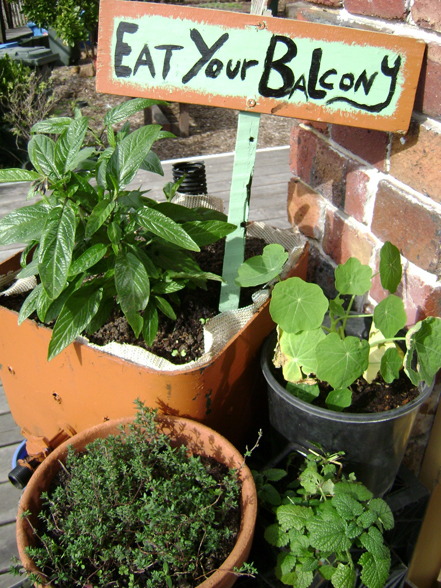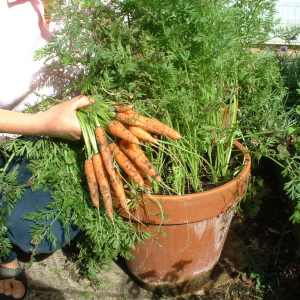Container Gardening
More Information
Container gardening can be very productive and rewarding for small spaces; I like to say ‘you can’t grow wrong’ with using containers. With the correct conditions you can succeed—fertile soil, water, sun and even companion and edible flowers added your vegetable or herb containers can make the most beautiful, colorful and tasty additions to your balcony, patio, or courtyard—even indoors on the windowsill. Well-designed containers placed strategically around your living space can make the home more welcoming and act as attractive focal points in your yard.The great thing about container gardening is it is often easier than growing a typical garden. There is less weeding and bending involved making it ideal for those with limited mobility. In addition, deer, rabbits and other wildlife are less likely to dine on plants in your container garden so it makes the option perfect for those with pesky critters.
Pots and containers can be moved fairly easily giving you the opportunity to shift them around for a change of scenery, or a seasonal change. Container gardening has become very popular in urban areas, with the rising costs of food and the simple fact that you know that your food is healthy and organic. Plus, nothing tastes better than a homegrown tomato, or fresh cut herbs added to a meal.
WHAT TO GROW
A wide variety of seasonal food crops can be grown successfully in containers—even some dwarf variety of fruit trees. Herbs, tomatoes, peppers and eggplant are generally the most productive in containers with high yielding varieties available. Have a shadier spot? Well, that’s okay too because lettuce, greens, kale and bok choy will grow well. Of course, why not try anything from zucchini to artichokes? The possibilities are really limitless. Strawberries are great in hanging containers, tomatoes also do well in upside down type containers. If floor space is limited, why not utilize all that valuable space with hanging baskets.
Companion planting in containers can provide the best bang for your buck–giving you the most out of your container also benefiting your plants and creating bright cheery containers for your outdoor area. Keep in mind when companion planting that shallow rooted plants prefer to grow near deep rooted plants so each plant can get their nutrients from different levels. In addition, some smaller plants like a bit of weather protection they get from bigger plants. Growing tomatoes and basil together increases the vigor and flavor of both crops and together they make a delicious salad. Add a few marigolds in with your tomatoes and basil for a pop of color also helping to repel several harmful insects.
Lettuce and onions are a great success when planted together, both are easy to grow and you can create some beautiful arrangements using different color varieties of lettuce. The Chamomile herb is a great companion with the sweet fragrance and pretty flowers it brings potassium, sulfur and calcium to the surface of the soil. Nasturtiums deter blackfly away from vegetables, adding great color and are also edible.
Get the most out of your garden by experimenting with the many companion plant combinations in a container this season. 
CONTAINERS
Of course, you can get very creative with container gardening; use anything from old wash tubs, pallets, clay or plastic pots, hanging baskets, almost anything that is deep enough to add soil and a drain base. Pots that are too small will restrict the root area and cause the soil to dry out too quickly and stunt the growth of the plant. Keeping your containers moist is the biggest factor, in some cases you may need to water daily since container soil heats more quickly than ground soil. This can be an advantage where plants may mature more quickly.
Proper drainage is also key to being successful at container gardening. Choose containers with drainage holes and by adding one to two inches of rocks and broken clay pots to the base under the soil you can help ensure proper drainage for your plants.
Fertile soil and regular feeding is another key component to productive container gardening. Most potting soil blends sold in stores do not have enough accessible nutrients for your plants; you will need to add those. When making up your soil mixture for your vegetable containers a 50-50 mix of good compost and sphagnum peat-based potting soil yields excellent results.
Now to choose a good organic fertilizer for regular feeding—it will be important to keep your vegetable containers well fertilized for higher yields. I like to use a combination of Epsom salts added to water during the growing period, about ¼ cup of Epsom salts to one gallon of water every five to seven days. Epsom salts are a natural source of magnesium which enables roots to absorb much needed nutrients from the soil.
If you notice any leaf discoloration a boost of Epsom salts will do wonders for everything in your garden from roses to lawns and vegetables. During production of your container garden, fertilizing at least once weekly with an organic fertilizer will be very important, a fish fertilizer is a good choice and available at most nurseries, but be sure to follow the directions on the label.
Container gardens can be enjoyed for one season and discarded, or designed to last for years. Use your imagination, combine upright and trailing plants, edibles and flowers.
Read it here http://saratogatodaynewspaper.com/index.php/today-in-saratoga/family/item/1232-gardening-in-small-spaces-and-yards

